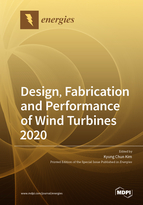Design, Fabrication and Performance of Wind Turbines 2020
A special issue of Energies (ISSN 1996-1073). This special issue belongs to the section "A3: Wind, Wave and Tidal Energy".
Deadline for manuscript submissions: closed (30 June 2020) | Viewed by 21395
Special Issue Editor
Interests: organic rankine cycle; heat transfer and heat exchangers; thermodynamics; experimental fluid mechanics; numerical modelling; advance power generation technologies
Special Issues, Collections and Topics in MDPI journals
Special Issue Information
Dear Colleagues,
The consumption of fossil fuels has increased, resulting in high CO2 emissions and serious climate change. Research on renewable energy is actively underway in order to solve these environmental problems, and in anticipation of the depletion of fossil fuels. Wind energy is an environmentally-friendly renewable energy source that does not cause environmental pollution, and its use is rapidly spreading around the world. From small-scale vertical axis wind turbines for urban usage to large-scale horizontal axis wind turbines for offshore wind farms, design, fabrication, and optimization technologies are highly required to manage wind energy effectively. Moreover, some new potentials, such as wind farm design, fluid-structure interaction, aero-acoustics, fabrication methods and performance tests by experimental and computational fluid dynamics should be engaged in modern wind turbine communities. Basic objectives are improving the reliability, promoting high efficiency of wind turbines, dynamic performance, reducing wind turbine generated noise and improving power generation efficiencies through high-fidelity approaches. Managing such a wide range of wind turbine scales and usages, design, fabrication, and performance test protocols for various wind turbines is a challenging issue. This Special Issue aims at encouraging researchers to address solutions to overcome the issue.
Prof. Dr. Kyung Chun Kim
Guest Editor
Manuscript Submission Information
Manuscripts should be submitted online at www.mdpi.com by registering and logging in to this website. Once you are registered, click here to go to the submission form. Manuscripts can be submitted until the deadline. All submissions that pass pre-check are peer-reviewed. Accepted papers will be published continuously in the journal (as soon as accepted) and will be listed together on the special issue website. Research articles, review articles as well as short communications are invited. For planned papers, a title and short abstract (about 100 words) can be sent to the Editorial Office for announcement on this website.
Submitted manuscripts should not have been published previously, nor be under consideration for publication elsewhere (except conference proceedings papers). All manuscripts are thoroughly refereed through a single-blind peer-review process. A guide for authors and other relevant information for submission of manuscripts is available on the Instructions for Authors page. Energies is an international peer-reviewed open access semimonthly journal published by MDPI.
Please visit the Instructions for Authors page before submitting a manuscript. The Article Processing Charge (APC) for publication in this open access journal is 2600 CHF (Swiss Francs). Submitted papers should be well formatted and use good English. Authors may use MDPI's English editing service prior to publication or during author revisions.
Keywords
- wind turbines
- design
- fabrication
- performance test
- control
- optimization
- aerodynamics
- aero-acoustics
- computational fluid dynamics
- wind farm






